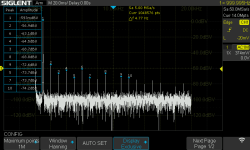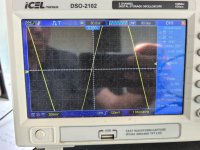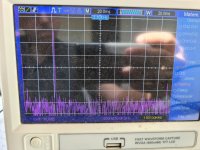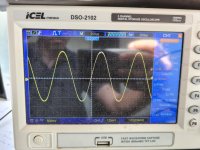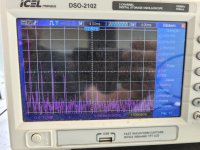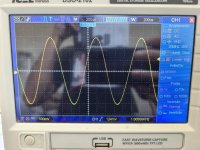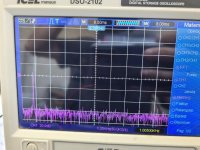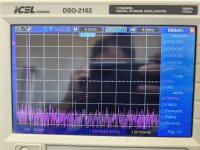Hello,
I have problems in measuring distortion with SDS1104X-E oscilloscope. (yes, this is not the best device to do so, and there are other solutions: I know, this post is about this specific method)
ok, so here is the problem - really interested if this is a setup mistake or an issue with the device although it is brand new
Test signal: - 1kz sin wave 1 Vrms on channel 1.
Math FFT setup: Hanning, 1Mpoints
BNC to BNC cable, no special probe, no attenuation
Grounded scope socket
No special devices, e.g motors, lights to interfere with
I get a pretty much the same measurement result independent of the source: Siglent SDG 2042x signal generator, same sin wave through MOTU M2 audio interface which should have very low distortion. the FFT shows a lot of harmonics as in the picture below.
Please share your opinion on this - I have tried multiple settings both on source generator and oscilloscope but always end up with this result.
I have been using MOTU interface with REW software to measure distortion and I am pretty sure the problem is not with the signal generation.
scope details
It would be great if someone could try to reproduce this test, with the same source or different
The scope was bought as new but I believe is an old stock with perhaps older HW version.
Thank you!
I have problems in measuring distortion with SDS1104X-E oscilloscope. (yes, this is not the best device to do so, and there are other solutions: I know, this post is about this specific method)
ok, so here is the problem - really interested if this is a setup mistake or an issue with the device although it is brand new
Test signal: - 1kz sin wave 1 Vrms on channel 1.
Math FFT setup: Hanning, 1Mpoints
BNC to BNC cable, no special probe, no attenuation
Grounded scope socket
No special devices, e.g motors, lights to interfere with
I get a pretty much the same measurement result independent of the source: Siglent SDG 2042x signal generator, same sin wave through MOTU M2 audio interface which should have very low distortion. the FFT shows a lot of harmonics as in the picture below.
Please share your opinion on this - I have tried multiple settings both on source generator and oscilloscope but always end up with this result.
I have been using MOTU interface with REW software to measure distortion and I am pretty sure the problem is not with the signal generation.
scope details
- sw version: 6.1.37R17
- hw version: 01-05
- FPGA version: 2021-11-08
It would be great if someone could try to reproduce this test, with the same source or different
The scope was bought as new but I believe is an old stock with perhaps older HW version.
Thank you!
Attachments
What are results with lower signals?
I.e does the distortion fall faster than a reduction in signal?
I.e does the distortion fall faster than a reduction in signal?
Do you get betterr results with REW?
I mention this because I have tried my Picoscope PC scope and it always gives a much worse result than REW. (with a Behringer UAC222 audio interface).
I can't find out why except to say that scopes are not specifically desgned for audio measurements.
I mention this because I have tried my Picoscope PC scope and it always gives a much worse result than REW. (with a Behringer UAC222 audio interface).
I can't find out why except to say that scopes are not specifically desgned for audio measurements.
Yes, I have tried REW with MOTU M2 in a loop and it gives -90dB or lower
I was trying to replicate the measurement done by johnaudiotech with a Siglent scope which spec wise seems to be more outdated than the 1104X-E
I was trying to replicate the measurement done by johnaudiotech with a Siglent scope which spec wise seems to be more outdated than the 1104X-E
You've hit the nail on the head. Obvious when you think about it. The Picoscope I use is only 8bit.Most scopes have an 8 bit ADC, and DNL and INL (dynamic and intetral non-linearity) are at the 8 bit level. This is what you get...
Agree, on an 8 bit scope (not considering oversampling) the best resolution would be 0.4% or -48dB, but at the same time, if the distortion level of the measured signal is lower than -90dB, it "shows" too many artifacts, which means that the ADC performance is rather poorMost scopes have an 8 bit ADC, and DNL and INL (dynamic and intetral non-linearity) are at the 8 bit level. This is what you get...
Did you first check the sine wave signal before move to Math FFT menu? Sometimes the signal is clipped and the result is this strong distortion.
What I do: first I adjust the sine wave scale to be let's say at 70% and then I move the menu to FFT Math.
I have 8-bit DAC scope not as good as yours and I don't see these harmonics.
What I do: first I adjust the sine wave scale to be let's say at 70% and then I move the menu to FFT Math.
I have 8-bit DAC scope not as good as yours and I don't see these harmonics.
Yes, that is the first step I did, as well as having enough waveform cycles, no clipping. This is why it doesn’t make too much sense and suspect something wrong with the HW. Is that an 8-bit scope you are using?Did you first check the sine wave signal before move to Math FFT menu? Sometimes the signal is clipped and the result is this strong distortion.
What I do: first I adjust the sine wave scale to be let's say at 70% and then I move the menu to FFT Math.
I have 8-bit DAC scope not as good as yours and I don't see these harmonics.
Thx for the effort to make the measurements. They seem ok if you have a decent signal source. I see some harmonic below -80dB but that is ok I assume.
Last edited:
The artifacts are produced by the 8-bit ADC. It can't resolve below -48dB.Agree, on an 8 bit scope (not considering oversampling) the best resolution would be 0.4% or -48dB, but at the same time, if the distortion level of the measured signal is lower than -90dB, it "shows" too many artifacts, which means that the ADC performance is rather poor
ADCs for audio have 16 to 20 bits.
Ed
Hi, yes my scope is based on 8-bit DAC. This is probably a rebranded Hantek assembled in Brazil under local brand.Yes, that is the first step I did, as well as having enough waveform cycles, no clipping. This is why it doesn’t make too much sense and suspect something wrong with the HW. Is that an 8-bit scope you are using?
Thx for the effort to make the measurements. They seem ok if you have a decent signal source. I see some harmonic below -80dB but that is ok I assume.
I made another capture now using a better signal source.
Note that my scale was in 10dB/div and yours were 20dB/div, so that's why I was not seen the same.
So I captured both to compare and now it's similar to yours.
8-bit s/n is really limited to 48dB.
Attachments
Absolutely, but its worse than that, standard 'scope front-ends are optimized for bandwidth and phase distortion, but not for linearity (harmonic distortion), so even if you have an averaging mode that increases the ENOB from 8 to 11 or whatever, you won't necessarily see improvement in its base-line distortion. Given the bandwidth of 100MHz or more we are talking about an RF amplifier, not an audio amp, so different constraints apply to the front end from an audio preamp, especially in a budget 8-bit DSO...The artifacts are produced by the 8-bit ADC. It can't resolve below -48dB.
ADCs for audio have 16 to 20 bits.
Ed
On the Siglent the averaging mode is on the Acquire button IIRC.
ENOB = effective number of bits - you can average 8 times to gain 3 more bits, etc.
Don't know if it's helpful, but Eddie at Kiss Analog has a good video on setting up a Siglent 1202 for FFT:
I have an 1104 XE so I just tried the same test- I got much different results. While not "audio grade" they are pretty useful: The source is a pretty clean AP S1 (-108 dB THD+N).

However, when I change the source from 25 Ohms to 600 Ohms the distortion increases a lot. This is something I will take up with the Siglent people on EEV Blog. It should not happen under any circuimstances.
However, when I change the source from 25 Ohms to 600 Ohms the distortion increases a lot. This is something I will take up with the Siglent people on EEV Blog. It should not happen under any circuimstances.
Here's what I get with 3 extra bits ERES setting on the Acquire menu with a 1k signal that's actual highest harmonic is 2nd at -90dB or so:

So that's become -52dB or so, about 8 ENOB rather than the 11 you'd expect - I am not sure ERES works for Math functions really. Anyway what's to be expected for 8 bit 'scope.
I turned on lots of averaging to see that nice flat noise floor, and I'm using flattop window as we are measuring peak heights.
So that's become -52dB or so, about 8 ENOB rather than the 11 you'd expect - I am not sure ERES works for Math functions really. Anyway what's to be expected for 8 bit 'scope.
I turned on lots of averaging to see that nice flat noise floor, and I'm using flattop window as we are measuring peak heights.
- Home
- Design & Build
- Equipment & Tools
- Siglent SDS1104X-E distortion measurement issue
